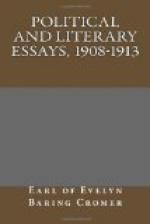that the English bethought themselves of improving
their newly acquired province by the construction
of a railway, and it was not till 1877 that the first
line from Rangoon to Prome—a distance of
only one hundred and sixty-one miles—was
opened. During all this time King Mindon ruled
in native Burma. He “gave abundant alms
to monks,” and, moreover, which was perhaps
more to the purpose, he was wise enough to maintain
relations with Great Britain which were “quite
cordial.” Eventually the Nemesis which
appears to attend on all semi-civilised and moribund
States when they are brought in contact with a vigorous
and aggressive civilisation appeared in the person
of the “Sapaya-lat,” the “middle
princess,” who induced her feeble husband, King
Thibaw, to carry out massacres on a scale which, even
in Burma, had been heretofore unprecedented.
Then the British on the other side of the frontier
began to murmur and “to consider whether it
was possible to endure a neighbour who was so cruel
and so unpopular.” All doubts as to whether
the limits of endurance had or had not been reached
were removed when the impecunious and spendthrift
king not only imposed a very unjust fine of some L150,000
on the Bombay-Burma Trading Corporation, but also had
the extreme folly to “throw himself into the
arms of France”—a scheme which was
at once communicated by M. Jules Ferry to Lord Lyons,
the British Ambassador in Paris. Then war with
Burma was declared, and after some tedious operations,
which involved the sacrifice of many valuable lives,
and which extended over three years, the country was
“completely pacified” by 1889, and Lord
Dufferin added the title of “Ava” to the
Marquisate which was conferred on him.
In 1852, when Lord Dalhousie annexed Lower Burma,
Rangoon was “merely a fishing village.”
It is now a flourishing commercial town of some 300,000
inhabitants. In 1910-11 the imports into Burmese
ports, including coast trade, amounted to L13,600,000.
The exports, in spite of a duty on rice which is of
a nature rather to shock orthodox economists, were
nearly L23,000,000 in value. The revenue in 1910
was about L7,391,000, of which about L2,590,000 was
on Imperial and the balance on local account.
Burma is in the happy position of being in a normal
state of surplus, and is thus able to contribute annually
a sum of about L2,500,000 to the Indian exchequer,
a sum which those who are specially interested in
Burmese prosperity regard as excessive, whilst it is
apparently regarded as inadequate by some of those
who look only to the interests of the Indian taxpayers.
The account which M. Dautremer, who was for long French
Consul at Rangoon, has given of the present condition
of Burma is preceded by an introduction from the pen
of Sir George Scott, who can speak with unquestionable
authority on Burmese affairs. It is clear that
neither author has allowed himself in any way to be
biassed by national proclivities, for whilst the Frenchman
compares British and French administrative methods




